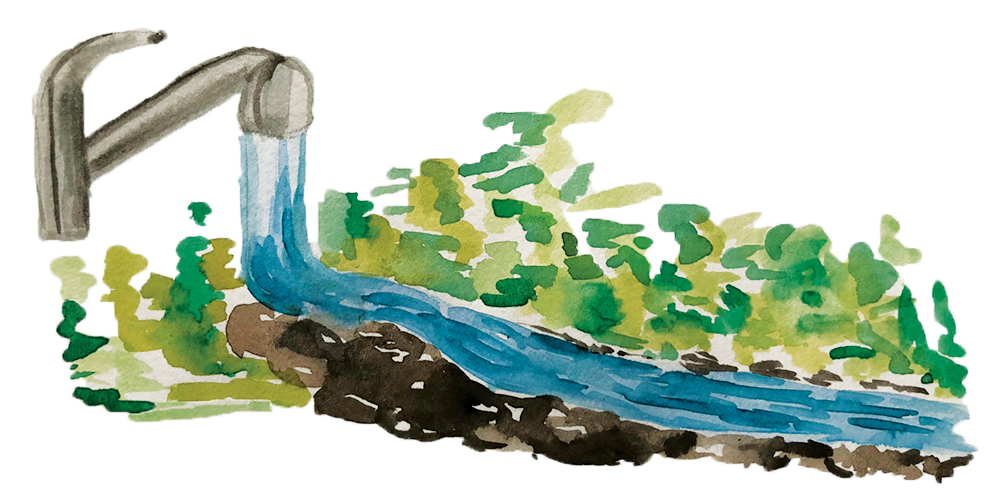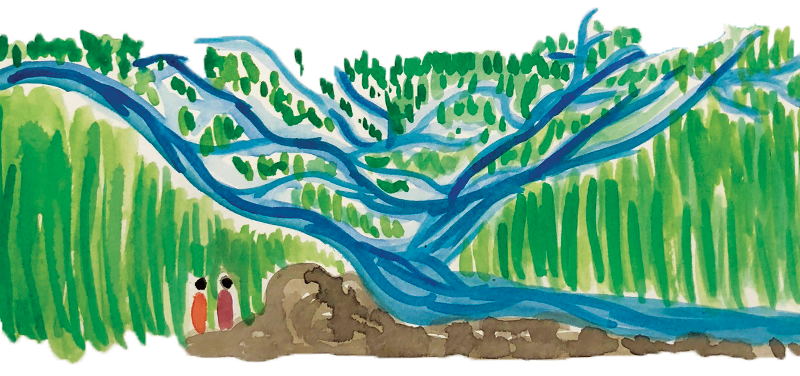Sometime in the year 2000, I think, I came across a news story reporting that explorers had found the source of the Amazon, the world’s largest river. The group making the discovery was an international, 22-person expedition sponsored by three of our most potent supporters of scientific research: the Smithsonian Institution, the National Geographic Society, and the Defense Department. With the aid of satellite mapping technology, laptop computers, and the Defense Department’s global-positioning satellite system, the explorers located “the point of flowing water the farthest distance from the mouth” as a tiny stream high on a slope of an 18,363-foot mountain in Peru called Nevado Mismi.
Having grown up with a love of exploring and a fascination with maps, I could relate to this story and imagine what an adventure it must have been. Half a century earlier, when we were 11, my friend Owen and I went on an analogous venture one August day and made a structurally similar discovery: the source of Shrine Park Creek, just outside of Leavenworth, Kansas. The creek arose west of town, winding eastward through Shrine Park before entering the city limits. In town it meandered through an industrial area, then inched past a row of tarpaper shacks and oozed through the city dump before emptying into the Missouri River.
Like the Amazon explorers, we had technological help: a topographical county map I had ordered from the University of Kansas. On this map Shrine Park Creek was named Five Mile Creek. At first I thought that was because the creek was five miles long. Two miles up the Missouri River, the map called the sluggish stream that went through the middle of town Three Mile Creek, and about two miles in the other direction, the map showed Seven Mile Creek emptying into the river. On the map the creeks looked roughly the same length, which puzzled me. Later, it occurred to me that their official names probably functioned as frontier-era markers of the distance from Fort Leavenworth, which bordered the north of town.
The map showed two distinct main branches of our stream forking above Shrine Park. The two forks looked about the same length. The Amazon explorers, who had narrowed their choice to five streams flowing down Nevado Mismi, used their satellite technology to measure which fork was the longest and thus which one to follow. Owen and I just eyeballed the two forks on the map, then chose the one which would leave us the closer to town. Owen was concerned about the time it might be taking. He had not told his mother we were doing this, and she would be angry if he came home late.
With the topological map as our guide, we followed our chosen fork through farms and woods. We enjoyed imagining ourselves as intrepid explorers of largely uncharted territories harboring unknown wonders and horrors. Our most arduous challenge was negotiating the many barbed wire fences that separated farm from farm. There was no open range in Kansas any more. All the land, even the woods, had been measured and claimed decades before, drawn and quartered, and was private property. The wildest beasts we saw were frogs and turtles. We were startled by a stray cow that suddenly bolted from the brush and half-slid down the creek bank. We stepped in a lot of mud, our feet got tired, and we got thirsty, but that was the extent of our sufferings.
The creek narrowed to a trickle until it almost petered out in a clearing near the top of a slightly concave, bowl-like pasture that descended from a ridge along which ran a minor state highway leading into town. Halfway up the hill was a small murky farm pond. All Kansas farm ponds are murky, especially in August. Nothing on the uphill side of the pond looked like a stream — no gully, rivulet, or even small ditch. With the same logic that the sophisticated Amazon explorers used half a century later, we declared the pond to be the source of Shrine Park Creek, for that was the furthest point from its source that water started to flow into it. Then we climbed to the road and headed back towards town.
We were dehydrated but elated, laughing hysterically at whatever popped into our heads. We arrived home late in the afternoon, and stopped first at Owen’s house. Owen’s mom glared at us as we entered. Owen tried to preempt a scolding by shouting triumphantly, “We discovered the source of Shrine Park Creek!” Unimpressed, she laid into him. “But Mom, we found the actual source of Shrine Park Creek!” She remained unimpressed.
Despite our sense of accomplishment, something bothered me about it. When I read about the discovery of the source of the Amazon 50 years later, the puzzling matter came back to me. There was that other fork of Shrine Park Creek. We had arbitrarily, and with an element of self-interested bias, chosen which fork to follow. But even assuming our fork was the longer of the two, roughly half the water entering Shrine Park Creek proper where the forks joined came from that other fork. And then there were those little streamlets that fed our fork. The tiny trickle exiting our pond must have represented not even one percent of the creek’s ultimate volume. And what was the source of the water in the pond? Most of it would have come down the slope above the pond. Was there a point somewhere on that ridge that was farther from the pond than any other point? Some spot on that state highway? Would that point be the true source of Shrine Park Creek? But what was the source of that water? Rain. And how much rain, on a point? A drop or two every once in a while? How could a single rain drop, or even several, be the source of Shrine Park Creek?
I have a clue to solving the paradox, and in all likelihood, you do, too: there is no source of Shrine Park Creek. There is no source of the Amazon (since that 2000 discovery, new expeditions have claimed new sources for the river). Even if one adopts the arbitrary definition of “source” as the furthest point of flowing water, that point will vary according to season and weather. In a heavy downpour, flowing water surely could be observed at or very near the top of that ridge in Kansas or the very top, perhaps on the highest pebble, of Nevado Mismi. In a drought, that Kansas farm pond could dry up. In a drought, the tiny stream on Nevado Mismi’s slope would begin its flow further down the mountain.
And then there is the problem that the furthest point of water, wherever it is, represents only an infinitesimally tiny proportion of the water that makes up the main stream, whether it be piddling Shrine Park Creek or the mighty Amazon. Imagine walking along that ridge above the Kansas farm pond, tracing in effect the Great Shrine Park Creek Divide, on one side of which all rain flows into Shrine Park Creek, and on the other, all rain flows into Three Mile Creek, Seven Mile Creek, or streams west of the Great Shrine Park Creek Divide. Are all the drops of rain — millions of them in an average rainstorm — that fall on the Shrine Creek side of the Great Shrine Park Creek Divide the creek’s source?
Is the source of a stream the rain or the clouds that drop the rain? Is the source of the stream the surface water that as vapor rose to form the clouds? What surface water? Raindrops falling into Shrine Park Creek might have originated in a Rocky Mountain tarn warmed by the rising sun, or in the Pacific Ocean, or in what’s left of the Aral Sea, or all three among many other sources. The rivers and streams of the world may well be simply trade routes in a vast ongoing interchange of water. For all I know, a bit of the Yalu may course with Shrine Park Creek on one day, some drops from the Ganges on another day.
It doesn’t take a lot of education to have thought about these kinds of things. But the basic insight — that the notion of a “source” and of someone “discovering” it is ultimately just a construct – is more available to us in 2018 than it would have been in 1952, at least in Kansas. Immigration and world communication have increased the general awareness in the West of once-exotic world-views such as Hinduism and Buddhism, both of which attempt to dissolve boundaries of time and space. Our own Western skepticism about knowledge, identity, causation, and objective fact also sensitizes us to the shakiness of the concept of an identifiable single source of anything. “Deconstruction” is the term this skepticism is often given in literary theory, but a sense of the world as constant flow and interchange was planted in western thought from the beginning (that is, the “beginning”): Heraclitus: “All is flux.” Awareness of the elusiveness of measurable reality is common currency now, although how deeply understood is not at all clear to me.
And our culture is now drenched in feminism, which has its own distrust of reason, clarity, precision, measurements, and science — and of the claims made in their name. “We women,” says Daniel Deronda’s Gwendolen, “can’t go in search of adventures — to find out the North-West Passage or the source of the Nile, or to hunt tigers in the East.” She was no feminist, but her creator was, and there is a touch of mockery in Gwendolen’s lament. We know, as Gwendolen didn’t, that hunting tigers threatens the extinction of a species and upsets ecological balance, that seeking the North-West Passage overwhelmed cultures and spread disease, that discovering the source (“source”) of the Nile was like a trophy lock celebrating the rape of a continent.
We are too sophisticated to believe in much these days. Discovering the source of Shrine Park Creek was a song of innocence. Our songs now are all of experience — so steeped in experience, in fact, that I feel an urge to append a “blah, blah, blah” to the last few paragraphs. We even mistrust our own disillusionment. And yet in saying that, I’m at the same time aware that I’m projecting my own experience onto everyone else, some of whom, perhaps many of whom, may well be innocent. Every aging generation, it has been said, confuses its own decline with that of the world’s. It’s probably healthy to do one’s best to avoid the error. Ten years ago, Owen sent me a sunny email in which he mentioned our high school’s upcoming 15th reunion. “Incredible,” he wrote, “only yesterday we were following Shrine Park Creek to its source.” •
All illustrations by Isabella Akhtarshenas.






